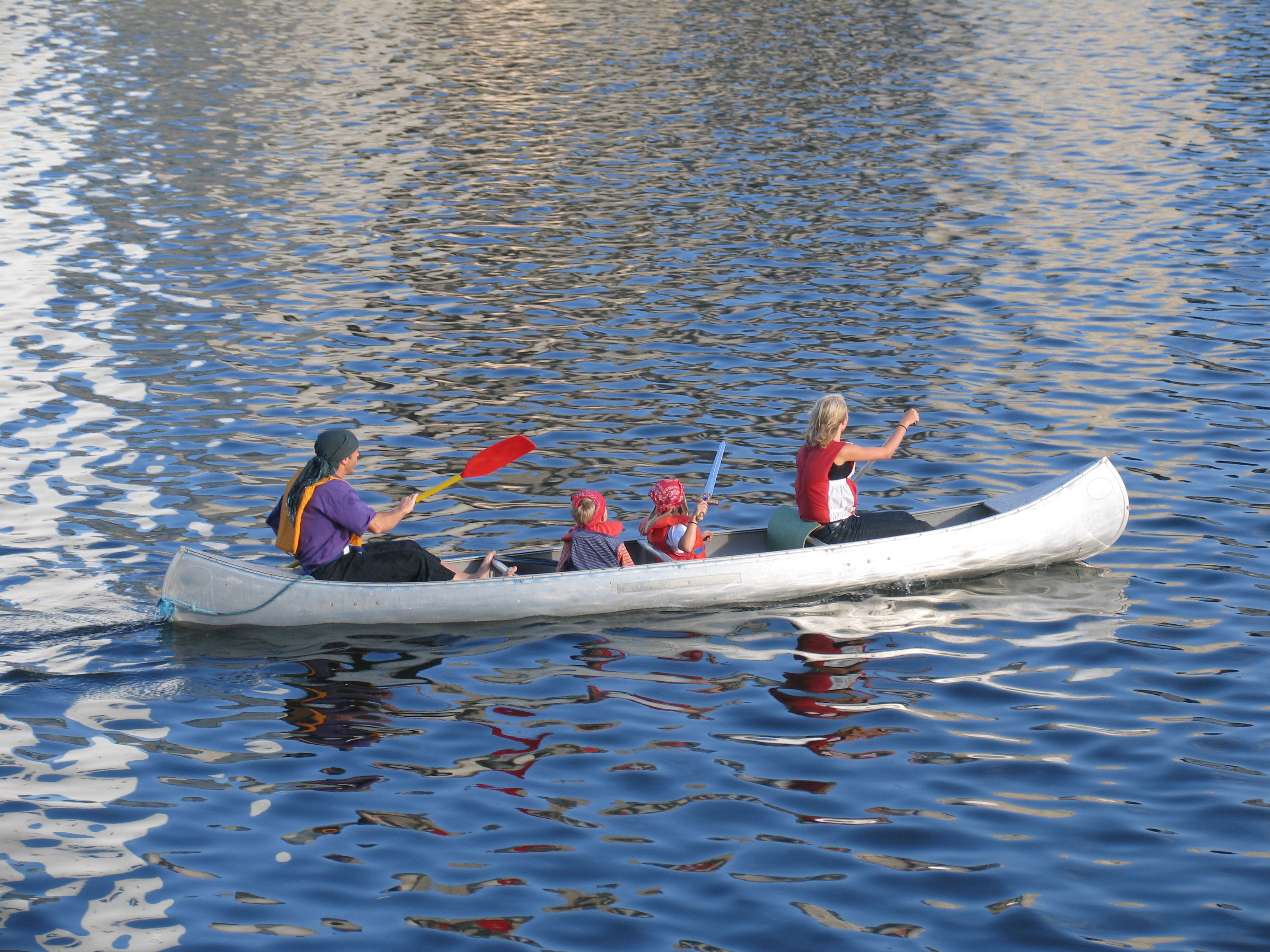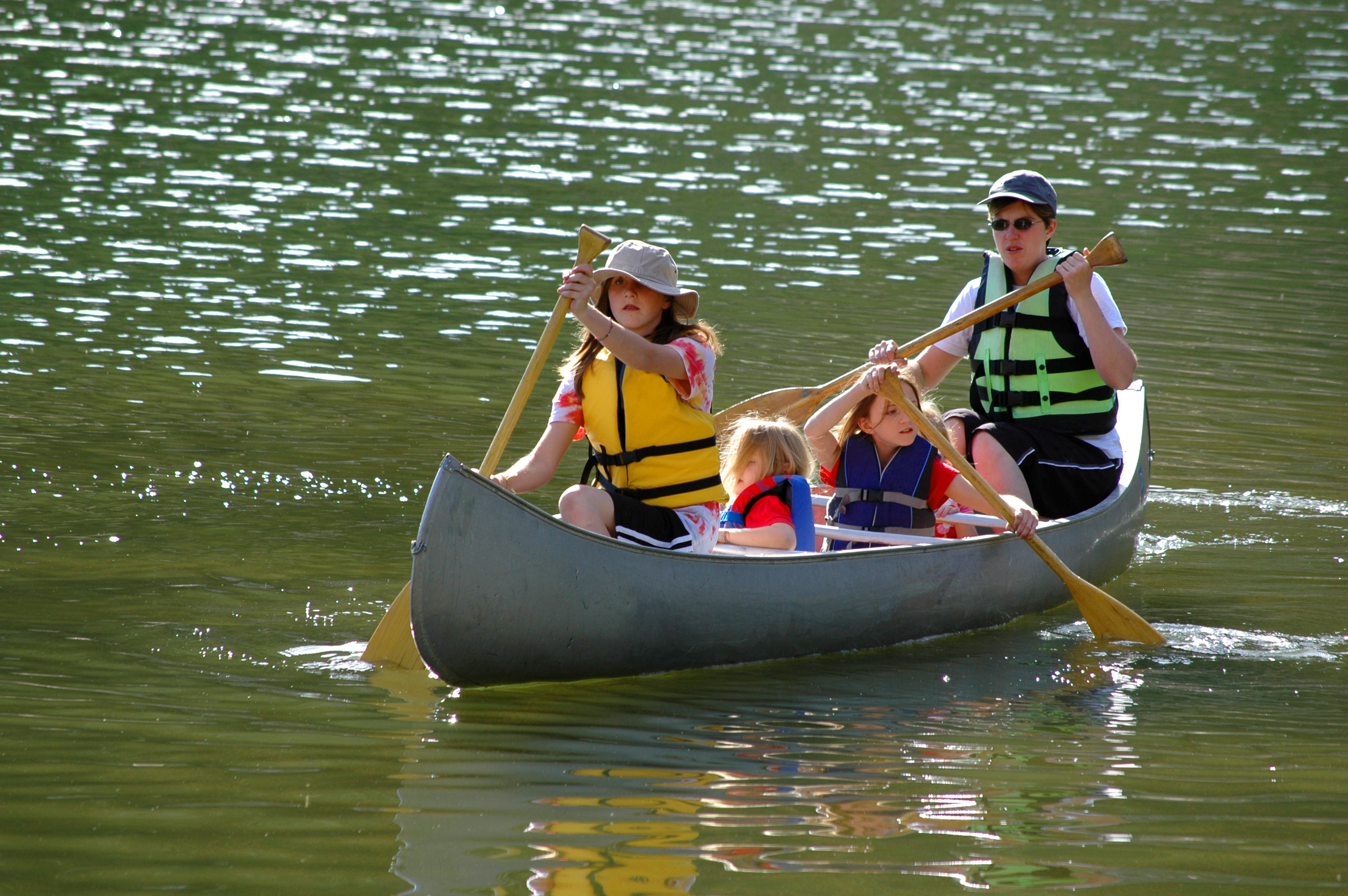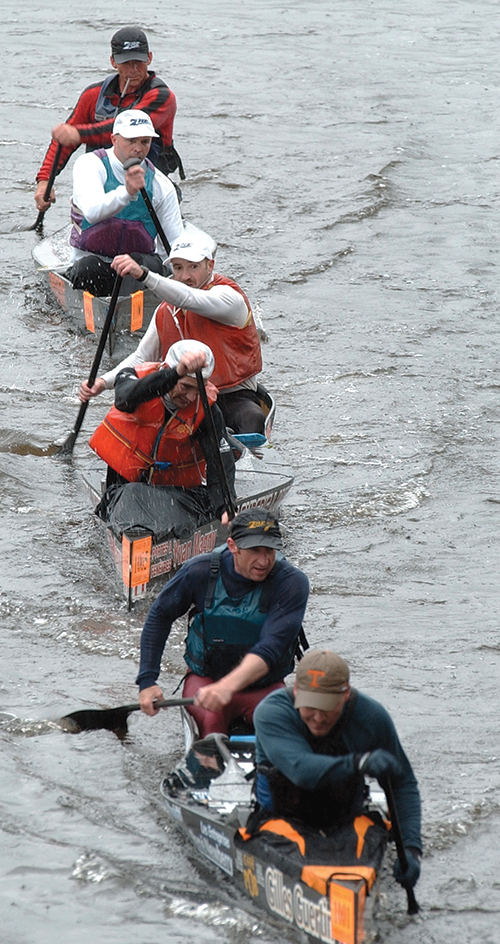Canoeing is a popular sport in which one or more people paddle a light, narrow boat called a canoe. Many people take canoes on camping, fishing, or hunting trips deep into wilderness areas. Others enjoy a peaceful canoe trip across a lake or an exciting canoe race down a river.

Canoes are easy to operate, maintain, store, and transport. They also cost less than other kinds of boats. However, canoeing can be dangerous. A canoeist should learn proper technique and basic safety rules from a qualified instructor.
Canoeing equipment
A canoeist needs only two basic pieces of equipment—a canoe and a paddle. Many canoeists also use a variety of other equipment. In addition, each person in a canoe should always wear a flotation device, such as a life jacket.
Canoes.
Most canoes measure from 11 to 20 feet (3.4 to 6.1 meters) long. They range from 35 to 40 inches (89 to 102 centimeters) in beam, the width at the widest point. Their depth varies from 12 to 14 inches (30 to 36 centimeters). Canoes can be made of aluminum, a synthetic fiber called Kevlar, fiberglass, plastic, inflatable rubber, or wood and canvas.
Most canoes are open boats—that is, they have no deck. Some have an enclosed deck with a cockpit where the canoeist kneels. Decked canoes closely resemble kayaks and are used in rough water where an open canoe would quickly fill with water (see Kayaking). Other canoes have one square end to which a small motor can be attached. Still other craft, called sailing canoes, have a mast and a sail but can also be paddled.
The design of a canoe reflects two opposing principles. Maneuverability is the ease with which a canoe can be operated. Stability is the quality that prevents it from turning over. In highly maneuverable canoes, the ends may be raised out of the water. The degree to which the ends are raised is called rocker. The more rocker a canoe has, the more easily it can spin and turn to miss obstacles. But it cannot travel in a straight line as well as a boat with less rocker. Stable canoes have flat bottoms. Some canoes even have a flat piece of metal or wood called a keel that extends into the water from the bottom of the hull. Such canoes hold a straight course easily but are difficult to maneuver on a river.
Paddles.
Most canoe paddles are made of wood, but some are made of aluminum, carbon fiber, fiberglass, or plastic. Wood paddles must be examined yearly for splits. The other types are more durable and require less maintenance. Paddles vary in length. A canoeist should select a paddle that extends from the ground to eye level.
The type of paddle blade depends on a person’s needs and experience. A wide blade provides a powerful stroke but requires strength and skill to use. A narrow blade requires less strength but does not provide so much power. One popular type, the beaver tail blade, measures from 6 to 8 inches (15 to 20 centimeters) wide.
Other equipment
includes a bailer, which may be a coffee can or a small pump, to empty water from the canoe. Many canoes are fitted with a device called a yoke for carrying the craft. When canoeing in cold water, a person may wear a tight-fitting garment called a wet suit for protection. A backrest and kneeling pad may be used for comfort.
Canoeists should keep food, clothing, and camping equipment in waterproof storage bags. If the boat overturns, equipment in waterproof bags will float and can be recovered after the boat is righted. Equipment should not be strapped to the boat because its weight could make an overturned canoe too heavy to right. However, equipment can be strapped inside the canoe to prevent the loss of items.
Handling a canoe
A skilled canoeist follows certain procedures in handling a canoe safely and efficiently. The most important one involves maintaining balance in the canoe so it remains trim (level). This is done by evenly distributing the weight of the people and equipment in the craft, and by keeping the weight low in the canoe. The easiest way to do this is to kneel. Other procedures include (1) entering and leaving a canoe, (2) paddling and steering, and (3) portaging (carrying) a canoe.

Entering and leaving a canoe.
When entering a canoe, the canoeist faces the bow of the canoe, grips the near gunwale (rim of the craft), and puts one foot in the middle of the canoe. Then, with one hand on the near gunwale, the canoeist reaches for the far gunwale with the other hand. At the same time, the canoeist shifts weight onto the foot in the canoe and lifts the other foot aboard. When two canoeists are entering, the first on board sits in the stern and steadies the canoe for the second, who sits in the bow. When leaving a canoe, a canoeist follows the same procedure in reverse. If two persons are leaving, the one in the bow goes first.
Paddling and steering.
A canoeist should take a comfortable paddling position, either kneeling or sitting. Whatever position is used, the canoe must be kept trim at all times. When two canoeists are paddling, the one in the stern may use a slightly longer paddle, which enables the craft to be steered more easily. The two canoeists should paddle from opposite sides of the canoe, coordinating their strokes to move through the water efficiently and safely.
Canoeists use several kinds of paddle strokes. The most basic one is the forward stroke, which moves the canoe forward. The canoeist holds the paddle with one hand near the grip (top) and the other hand near the blade. The hands should be about as far apart as the width of the shoulders. The paddle is planted in the water, and the boat is pulled forward by the rotation of the canoeist’s torso.
Each bow stroke turns the canoe away from the side on which the stroke is made. Therefore, various strokes must be used to hold a straight course. One such stroke is the J-stroke, in which the top hand rotates downward so the thumb points toward the water and the paddle blade is pushed away from the boat. Other strokes maneuver the canoe backward or sideways. A canoe can be stopped by pushing the paddle forward in the water.
Portaging a canoe.
On some canoe trips, the canoe may have to be carried overland. On a river trip, for example, canoeists may want to avoid such obstacles as rapids or falls. Or the canoeists may want to reach a lake that lies several miles from the river. When portaging a canoe, the canoeists may use a padded yoke, which enables the canoe to be carried upside down on their shoulders.
Canoe racing
Canoe racing provides challenge and excitement. The several kinds of competition include (1) marathon racing, (2) white-water racing, (3) flat water, or sprint, racing, and (4) poling and sailing.

Marathon racing
can take place on any large body of water. The contestants speed over a course that can extend 20 miles (32 kilometers) or longer. The winner is determined by the fastest time. Men, women, and children compete in separate events.
White-water racing
was named for the rough, rapid water on which the race takes place. Open or decked canoes compete in these races. The winner is determined by the fastest time. There are two types of white-water racing, wildwater and slalom. A wildwater race is based on the endurance, skill, and strength of the racers. A slalom race features precise maneuvering of canoes through a series of poles called gates, which hang over the water.
Flat water racing,
also called sprint racing, an event of the Summer Olympic Games, takes place on the smooth water of a lake or lagoon. One, two, or four racers paddle each canoe over a course of 500 to 10,000 meters.
Poling and sailing
are special types of canoe racing. In poling racing, a canoeist propels the craft with a pole that measures from 12 to 14 feet (3.4 to 4.3 meters) long. Contestants in poling races maneuver upstream and downstream and around floating markers called buoys. Races are held in several classes of competition.
Canoe camping
Canoe camping became increasingly popular during the early 1970’s. Many people found they could use canoes to reach quiet, scenic sites far from crowded campgrounds. Canoe camping includes long trips through wilderness areas, as well as quiet weekends on a local lake or river. Information on the many campsites in North America may be obtained from state agencies or from the American Canoe Association in Newington, Virginia. The equipment taken on a canoe trip depends on such factors as the season, the amount of cargo space, and the amount of portaging involved. For a discussion of camping equipment, see the World Book article on Camping (Camping equipment and food).
History
The canoe developed from the seagoing dugouts of the indigenous (native) Carib people of the Caribbean islands. These dugouts were made from large tree trunks, which had been shaped and then hollowed out. The word canoe comes from kanu, the Carib term for such a dugout.
Native American people of North America made canoes by fastening bark, mostly birchbark, to a wooden frame or by hollowing out the trunks of trees. These light, swift canoes were ideal for the lakes, rivers, and streams of the continent.

During the 1600’s, canoes played an important part in the exploration of North America. In 1673, Louis Joliet, a French-Canadian explorer, and Father Jacques Marquette, a French missionary, traveled the Mississippi River in birchbark canoes.
